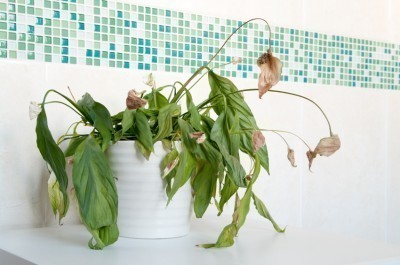
Fungal Diseases
Fungi are one of the most common factors of disease in houseplants. Most of these can be contributed to overwatering, as most fungi need moisture to thrive. Here are the most common fungal problems you may encounter with your indoor plants:
- Anthracnose – Anthracnose presents itself with leaf tips that become yellow, gradually turning dark brown and eventually dying. Infected leaves should be picked off and destroyed.
- Root and stem rot – Both root rot and stem rot can be associated with fungus, due mostly to overly wet soil from poor drainage or overwatering. Both the roots and stem become soft, turn brown/black, wilt and die. Generally, it’s too late to save the plant once you notice this disease; however, this can easily be prevented with the correct use of watering and good drainage. If only some of the roots are affected, however, repotting the plant in a sterilized pot may help.
- Leaf spots – Fungal leaf spots may include small brown spots with yellow margins or black spotting. Remove and destroy the affected houseplant as the fungi thrive on decaying plant matter. Neem oil can also help.
- Botrytis – Botrytis, or gray mold, is another disease brought on by fungi. This appears as fuzzy, gray mold on the foliage and stems. Since it spreads easily, it’s best to discard the entire plant and sterilize the pot. To prevent botrytis, inspect houseplants daily for brown or dead leaves and promptly remove them.
- Powdery mildew – Powdery mildew leaves a white powder-like coating on all parts of the plant. These infections are generally the result of fungi either from decaying plant matter or from airborne spores and high humidity. Good ventilation and careful watering is recommended. Allow the plant to dry out, placing in a sunny location, if necessary. For severely infected plants, remove and destroy.
Viral or Bacterial Diseases
Some houseplants develop viral or bacterial diseases. Those affected by a virus are not as common unless left outdoors; however, they may appear stunted in growth with crinkled leaves and mottled color. More often than not, viral infections are caused by insects, such as aphids and nematodes.
Houseplants affected by bacterial dropsy or edema exhibit water-soaked spots with cork-like swellings along the leaf surface and stem. Houseplants may not fully recover; however, repotting can help improve their chances, as well as drainage and ventilation. Otherwise, they should be removed and destroyed.






